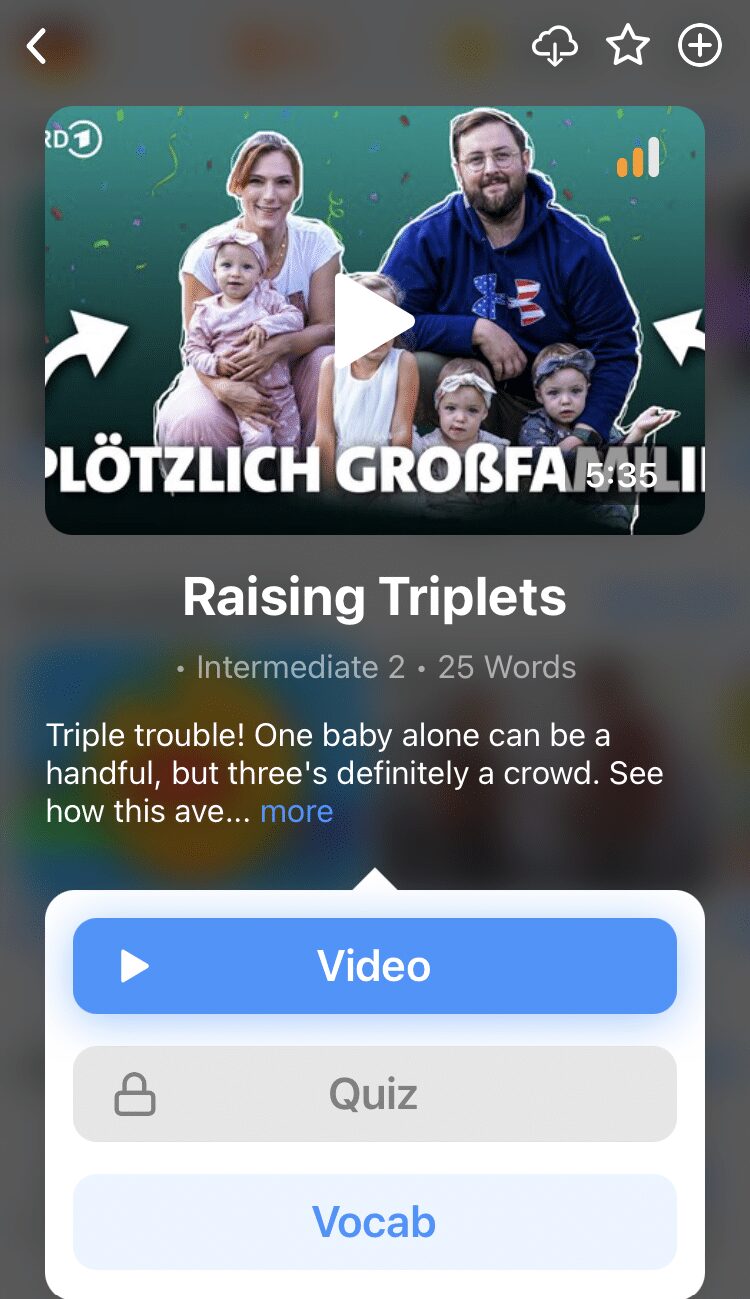The German Alphabet

The alphabet is the first step to any language, and beginner German learners are in luck. Fortunately, there aren’t many stark differences between the German alphabet (conveniently known as das Alphabet) and the English alphabet.
Here is a simple guide to the German alphabet.
Download: This blog post is available as a convenient and portable PDF that you can take anywhere. Click here to get a copy. (Download)
Letters of the German Alphabet

Similar to the English alphabet, there are 26 regular letters in das Alphabet. However, there are four other characters—Ä, Ö, Ü and ß—that are considered unique letters. We’ll go over these later.
Let’s start with the first 26. They’ll overall look familiar to you, but keep an eye on what might be different!
| Letter | Phonetic Spelling | Example Word |
|---|---|---|
| A | ah | Apfel (apple) |
| B | beh | Baum (tree) |
| C | tseh | Computer (computer) |
| D | deh | Dekoration (decoration) |
| E | eh | Essen (food) |
| F | eff | Frau (woman) |
| G | geh | Garten (garden) |
| H | ha | Haus (house) |
| I | eeh | Idee (idea) |
| J | yot | Jahr (year) |
| K | kah | Kaffee (coffee) |
| L | el | Lampe (lamp) |
| M | em | Mensch (person) |
| N | en | Nase (nose) |
| O | oh | Obst (fruit) |
| P | peh | Park (park) |
| Q | koo | Qualle (jellyfish) |
| R | err | Rad (wheel/bicycle) |
| S | ess | Sohn (son) |
| T | teh | Tochter (daughter) |
| U | ooh | Uhr (hour/time) |
| V | fow | Vogel (bird) |
| W | veh | Wagen (wagon) |
| X | ix | Xylofon (xylophone) |
| Y | üpsilon/ypsilon | Yak (yak) |
| Z | tsett | Zimmer (room) |
Fortunately, in terms of pronunciation, most of the German letters don’t stray too far from English ones.
Pronouncing German letters is, in many ways, not as “exaggerated” as pronouncing English letters. In many cases, pronouncing English letters often makes your lips stretch out into a thin, tooth-exposing smile. For German letters, your lips will usually be gently parted, so keep that in mind while you enunciate.
Letters that Are Different from English
Let’s focus on a few letters that differ from their English counterparts: J, U, V, W, Y and Z. Here’s a quick breakdown of what makes these six unique:
- The German J is pronounced more like the English Y. Example: Jahr is pronounced “yahr.”
- The German U is pronounced “ooh,” not English “yoo.” Example: Uhr is pronounced “oohr.”
- The German V is pronounced like the English F. Example: Vogel is pronounced “fogel.”
- The German W is pronounced like the English V. Example: Wagen is pronounced “vahgen.”
- The German Y is pronounced similarly to the English U. However, its pronunciation within words varies based on the word’s origin and where Y is positioned. Example: Yak is pronounced “yak,” dynamisch is pronounced “doo-nah-mish,” Psychologie is pronounced “psoo-koo-loo-gee.”
- The German Z is pronounced more like an English S, with some inflection. Example: Zimmer is pronounced “tsimmer.” Make sure that you slightly hiss at the beginning.
Of all the letters, it’s perhaps Y that might trip you up the most because of its finicky nature. Luckily, there aren’t too many native German words that contain Y. Many words with Y tend to come from other languages, which means their pronunciations can be quite intuitive.
The best way to practice these letters isn’t just by reciting them one by one. You should frequently listen to the speech of native speakers (ideally with a written transcript to read along) so you can get used to how things should sound.
One way you can do this is with the language program FluentU which utilizes interactive subtitles.
FluentU takes authentic videos—like music videos, movie trailers, news and inspiring talks—and turns them into personalized language learning lessons.
You can try FluentU for free for 2 weeks. Check out the website or download the iOS app or Android app.
P.S. Click here to take advantage of our current sale! (Expires at the end of this month.)
The Umlaut Vowels
There are three special characters created by taking the vowels A, O and U and adding something known as an umlaut to them.
An umlaut is represented by two dots over the letter. Its etymological meaning suggests what it does: umlaut, when translated, essentially means “around/about sound.” It slightly stretches the pronunciation of the letter in question.
The German alphabet has three umlauted letters:
- Ä – pronounced more like “eh”
- Ö – pronounced more like “ouh” (make a “eh” sound, then make your lips into a circle)
- Ü – pronounced more like “oo”/”uu” (make a “ee” sound, then make your lips into a circle)
While it’s usually easy for beginner learners to distinguish the umlaut vowels when hearing them, pronouncing them can come as a challenge. You need to make sure you aren’t just saying A, O and U as they sound normally.
The change in pronunciation does make a difference in what a word means. In German verbs, it can mean an entire change in tense. In German nouns, it commonly signals a switch from singular to plural.
For example, Apfel refers to one apple, but Äpfel refers to multiple apples—you’ll want to know this the next time you go to a German grocery market!
To get started on how to pronounce umlauted vowels, try this:
- Say the vowel as it would sound when not umlauted (say A as “ah”, O as “oh” and U as “ooh”)
- While vocalizing, pinch and pull the flesh of your cheeks to the sides. Make sure that your lips are being pulled!
- The manipulated sound will be a close approximation to the umlauted version of the vowel
Another thing to remember when enunciating: your lips should be in a kind of pouting or pursed position. This will be a sign that you’re exaggerating the vowels as you should.
Try to practice the difference between regular vowels and umlaut vowels with these words:
The Letter ß
It looks like a noodly B, but it definitely doesn’t sound like one.
ß is actually a special character known as the Eszett, and it’s entirely unique to the German alphabet. It’s considered a linguistic ligature, a fancy term describing a single letter meant to represent two or more letters.
In a word, ß functions like a double S, sounding like a hiss. For this reason, ß is also known as scharfes S (sharp S). As a memorization trick, you can imagine it looks like an awkward snake (or a snake doing some intense core workout, apparently).
Here are a few examples of words that use ß:
You’ll sometimes see the ß written as just “ss” in informal contexts, like on a social media post. For example, weiß (white) is sometimes written out as weiss. This makes it more intuitive for those unfamiliar with the German alphabet, which you certainly won’t be.
But keep in mind: this substitution doesn’t always work for certain words! It may warp the meaning entirely. A good example are the words Busse (buses) versus Buße (atonement). As a rule, the ß is typically used when it comes after a “long vowel” or diphthong.
While ß is used in most of mainland Germany and Austria, there are a few German-speaking regions that no longer officially use the eszett. Switzerland and Liechtenstein are two such places—instead of ß, they use ss. Keep this in mind if you ever want to hop over to those two countries!
If you need a catchy mnemonic to help you practice, then here’s a groovy German alphabet song sung by Grover (or Grobi, as he’s called in German) from Sesame Street.
Remember that, like in English, the sound of a letter by itself isn’t necessarily how it sounds when within a word. With constant exposure to authentic German vocabulary and speech, these 30 letters and their pronunciations will be a breeze to memorize.
Download: This blog post is available as a convenient and portable PDF that you can take anywhere. Click here to get a copy. (Download)
And One More Thing...
Want to know the key to learning German effectively?
It's using the right content and tools, like FluentU has to offer! Browse hundreds of videos, take endless quizzes and master the German language faster than you've ever imagine!
Watching a fun video, but having trouble understanding it? FluentU brings native videos within reach with interactive subtitles.
You can tap on any word to look it up instantly. Every definition has examples that have been written to help you understand how the word is used. If you see an interesting word you don't know, you can add it to a vocabulary list.
And FluentU isn't just for watching videos. It's a complete platform for learning. It's designed to effectively teach you all the vocabulary from any video. Swipe left or right to see more examples of the word you're on.
The best part is that FluentU keeps track of the vocabulary that you're learning, and gives you extra practice with difficult words. It'll even remind you when it’s time to review what you’ve learned.
Start using the FluentU website on your computer or tablet or, better yet, download the FluentU app from the iTunes or Google Play store. Click here to take advantage of our current sale! (Expires at the end of this month.)












